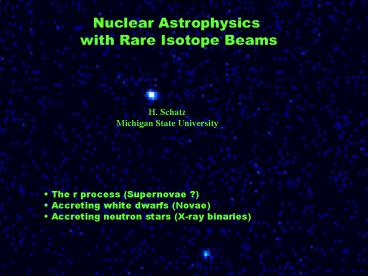Nuclear Astrophysics PowerPoint PPT Presentation
1 / 16
Title: Nuclear Astrophysics
1
Nuclear Astrophysics with Rare Isotope Beams
H. Schatz Michigan State University
- The r process (Supernovae ?)
- Accreting white dwarfs (Novae)
- Accreting neutron stars (X-ray binaries)
2
Rare Isotopes in Nuclear Astrophysics
p process
r process
Nova (Chandra)
Metal poor halo star (Keck, HST)
rp process
CS22892-052
solar r abundance
observed
abundance
Supernova (HST)
EC
Z
protons
crust processes
neutrons
E0102-72.3
3
The r (apid neutron capture) process
Creates half of heavy elements (gtFe).
- Open questions
- Where and How ?
- Probe supernovae or neutrinos ?
- Probe age of the universe with U/Th ?
Supernovae ?
Merging neutron stars ?
4
The r process path
Known mass
Known half-life
r process waiting point (ETFSI-Q)
Solar r-abundances
Calculated at NSCLNSCL Schatz, Toenjes Mainz
Kratz, Pfeiffer
N126
N82
5
Importance of nuclear physics for r process
calculations
n post-processingsignature
r process model calculations
N82 shell quenched
(Z,N)n (Z,N-1)nn
Full N82 shell gap
Shell structure strongly affects models
- Need Experiments to determine whether
- Shell is quenched
- or Astrophysical model is wrong
(same effectas b-n emission !)
6
Experimental opportunities at Rare Isotope
Facilities
for r process nuclei
Z82
RIA Reach
Z50
NSCL Reach
N126
Z28
Reach for at least a half-life measurement
N82
7
Nova observations
HST
Chandra
O
Ne
Mg
8
Nova ExplosionThermonuclear runaway on the
surface of an accreting white dwarf
.
Open Questions1) How is white dwarf material
mixed into the ejecta (and what is made by
nuclear burning) ? 2) Why do Novae eject 10 times
more matter than models can accrete ? 3)
Contribution to galactic g emitters ? ? Need to
understand nuclear physics to extract
information from abundance observations
9
reaction sequence in novae
Example ONeMg Nova, 1.35 M_sol white dwarf
(Starrfield 1996) t3min, Tmax0.36GK
Sulfur Observed ! (proof of rp process)
found to be important in Jose 1999
22Na (2.6y)
18F (110m)
26Al (7x105y)
13N (10m)
first direct RIB measurements done should be
completed
other important rates that should be measured
with RIBs
Short lived g-emitter
Techniques
Low energy direct measurements ( 1 MeV/u)
complementary
Coulomb Breakup at higher energies (100-400
MeV/u)
Indirect measurements of level properties
10
Accreting neutron star / X-ray binary
Artist View
Donor Star
Neutron Star
Observed
Accretion Disk
11
Nuclear reactions on accreting neutron stars
Thermonuclear burning (rp process)
- Why do burst durations vary ? (10s min)
Neutron Star Surface
- What nuclei are made in the explosion ?
H,He
- Galactic nucleosynthesis contribution ?
fuel
- Start composition for deeper processes ?
atmosphere
Deep H, C, burning
ashes
- Origin of Flares ?
- Origin of Superbursts ?
ocean
outer crust
Electron captures
Pycnonuclear reactions
- Gravitational wave emission ?
- Crust heating ?
inner crust
- Dissipation of magnetic fields ?
Need nuclear physics to answer and to understand
observations
12
Thermonuclear burning during X-ray burst
- Data needs
- masses (Sp)
- b-decay rates
- some (p,g) rates
- some (a,p) rates
rp process
ap process
H. Schatz, M. Ouellette (MSU) A. Aprahamian, V.
Barnard, M. Wiescher (ND) L. Bildsten, A. Cumming
(UCSB, ITP) T. Rauscher, F.-K. Thielemann
(Basel) Phys Rev Lett. 68 (2001) 3471
3a reaction
(Schatz et al. 2001)
13
(No Transcript)
14
Crust reactions in accreting neutron stars
From Haensel Zdunik 1990
border of known masses
Ni (28)
Electron capture
Fe (26)
Cr (24)
Ti (22)
ap/rp process
Ca (20)
Ar (18)
NSCLReach
S (16)
and so on
Si (14)
Mg (12)
Electron capture and n-emission
Ne
Pyconuclear fusion
H,He
Need to measure
- Masses (Exp 1035 Santi, Ouellette at S800)
- Electron capture rates (Exp 1038 Sherrill at
S800)
(Charge exchange in inverse kinematics (7Li,7Be) )
15
Chandra observations of transients
KS 1731-260 (Wijands 2001)
- Bright X-ray burster from 1988 -early 2001
- Accretion shut off early 2001
- Detect thermal X-ray flux from cooling crust
- Too cold ! (only 3 mio K)
- Constraints on duration of previous quiescent
phase - Constraints on neutron star cooling mechanisms
16
Conclusions
- New observations and new experimental
opportunities for rare isotopes together drive
nuclear astrophysics - Major advances can be achieved in understanding
of - r process
- Novae
- X-ray binaries(and more p process, EC in
supernovae, .) - Major first step at existing (new) facilities
possible - But RIA needed to answer open questions
- Complementary experiments at stable beam
facilities needed !

